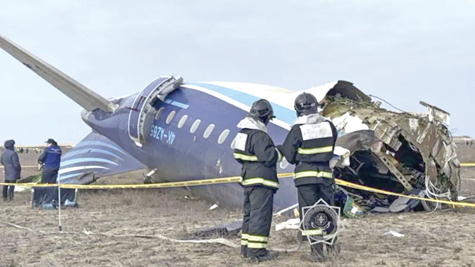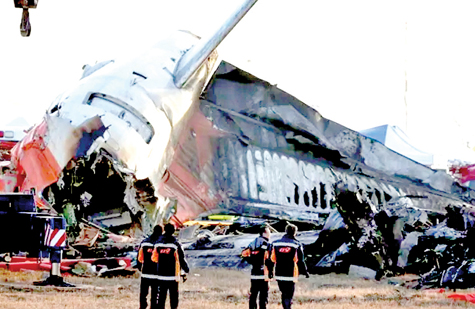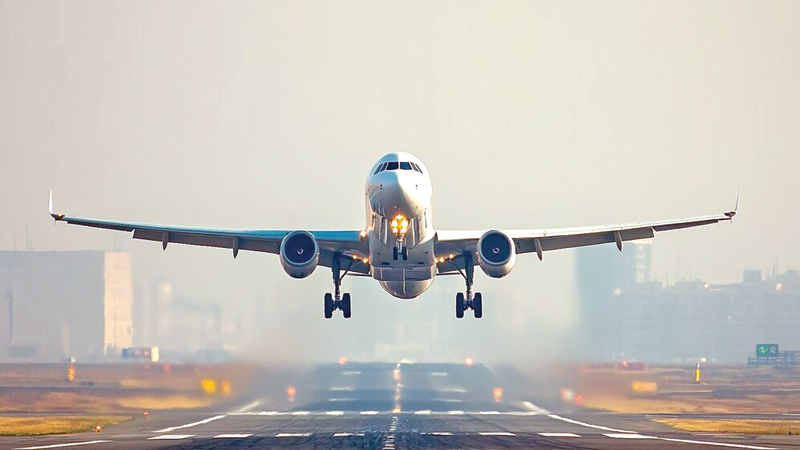 I am a seasoned flyer who takes quite a few flights every year, but even I cannot sometimes stop thinking that “I am in a flying metal tube 10,000 metres up in the air.” It is not an exactly comforting thought, especially when a gust of turbulence hits the plane.
I am a seasoned flyer who takes quite a few flights every year, but even I cannot sometimes stop thinking that “I am in a flying metal tube 10,000 metres up in the air.” It is not an exactly comforting thought, especially when a gust of turbulence hits the plane.
Yet, flying is actually the safest mode of transport. Your chances of being involved in a car accident are much greater. Indeed, even walking or cycling can be really dangerous depending on the terrain, traffic conditions and weather.
Just think of this – there are over 120,000 flights a day globally which carry around 12 million passengers. At any given time, there are over 12,000 planes in the air, excluding military planes, helicopters and recreational aircraft. The global aviation industry, worth around US$ 2.7 trillion, supports 65 million jobs on the ground and in the air (All statistics ICAO). There are hundreds of Government-owned and privately owned airlines around the world, most of which fly internationally, though some operate only domestic flights in their respective countries.
Today’s modern airliners or airframes such as the Boeing Dreamliner 787 family and the Airbus A350 family are much more structurally sound than their counterparts from just 30 years ago. Advances in materials, engines, avionics, communications, security and safety measures have made flying safer than ever before.

Rescuers work at the wreckage of Azerbaijan Airlines flight 8243
Yet, plane crashes do happen occasionally due to a variety of factors including pilot error, bad weather, mechanical faults, bird strikes and even “physical and technical external interference” – a reference to the Surface to Air (SAM) missile attacks that brought down Malaysia Airlines MH14 (2014) and Azerbaijan Airlines 8243 (2024).
On-board and mid-air explosions (bomb attacks) in planes are now extremely rare, thanks to modern security and scanning technology and stringent security adopted following the harrowing events of 9/11. Indeed, planes rarely fall out of the sky – most, if not all, aviation accidents occur when planes take off or land.
Crash of Jeju Air flight
The crash of Jeju Air flight 2216 in the closing days of 2024 came as a shock to the aviation world. The events leading to the loss of 179 lives —a bird strike followed by engine and perhaps landing-gear failure— suggest that multiple mishaps and failures can occur to bring down a plane. Amazingly, there were survivors in both crashes (Azerbaijan and Jeju), 29 in the former and just two in the latter. Indeed, the safety parameters of modern airliners are so good that it is possible for at least some passengers to survive a serious crash.
Behind every crash lies a series of missteps. It could be something very simple such as a loosened nut in a vital component or a wrong decision taken by the pilot or the co-pilot. But if you have watched NatGeo or Discovery shows such as Air Crash Investigation (ACI) or Seconds From Disaster, every air accident is meticulously investigated, with the debris combed piece by piece. The Black Box or the Flight Data Recorder (FDR) and the Cockpit Voice Recorder (CVR) are recovered from the crash site (these are completely waterproof in case the wreckage is in water) and analysed by investigators from bodies such as the National Transportation Safety Board (NTSB) in the US. Every accident has led to a significant improvement in airline and aviation safety.
The proper training of crew is the key to aviation safety. Pilots must complete refresher courses on simulators and real aircraft and the flight attendants must always be prepared to evacuate passengers from a fully packed plane in just 90 seconds. There are real-life examples for this – on August 3, 2016, Emirates flight number EK521 crashed upon landing at Dubai International Airport (DXB). All 300 passengers and crew onboard the aircraft survived the initial crash and were evacuated in just 90 seconds. The plane burst into flames shortly afterwards. This shows that all passengers can be saved even in a “hull-loss” event, if the crew act quickly.
However, as the Azerbaijan Airlines incident shows, war and other such factors can negatively impact aviation safety. Airlines have been cautiously avoiding the airspace around the two major theatres of war – Ukraine and Gaza/Israel/Lebanon, using more fuel for the detours. The Azerbaijani airliner found itself at the wrong place and the wrong time, as Russians were trying to counter Ukrainian drones.
Outside of conflict zones, drones flown by enthusiasts around major airports pose a severe threat to airlines, along with laser lights that can temporarily blind pilots. Bird strikes are another common factor – one was behind the famous “Miracle on the Hudson” in which all passengers onboard a US Airways flight that had ditched in the Hudson River, New York, were saved by ferries that were passing by. Bird strikes hardly give time for the pilots to act, with impact with the ground or water just seconds away.
Aviation analysts are also worried by the increasing number of incidents involving severe turbulence, especially “clear air turbulence” which can strike without warning. One passenger died and 71 were injured when a Singapore Airlines flight from London to Singapore encountered severe turbulence in May last year near Bangkok, where the plane eventually made an emergency landing.
Since then, there have been several such incidents that resulted in passenger and crew injuries. Scientists believe that this is also a side effect of Climate Change and will rise in frequency over the coming years. They are also evolving various methods to track areas where turbulence may develop and warn flight crews in advance. The US airline Delta already has such a sophisticated real-time turbulence and weather warning system.
Aviation experts are also worried about incidents where the pilots misunderstand or misread instructions given by Air Traffic Control (ATC) towers. Even though English is the universal language of aviation, not all ATC personnel and pilots are fluent in it. This could lead to misunderstandings that may even have fatal consequences. There were many recent incidents of Runway Incursions, where a plane which does not have authorisation to use the active runway (airports such as Colombo and London Gatwick have only one runway anyway) uses it, posing a grave danger to ground vehicles and planes which are actually authorised to use the runway at the given time. Ground collisions between aircraft (these are generally of a minor nature) and airport vehicles are also becoming common.
World’s biggest air travel disaster
While these are not generally very serious, near-misses and actual collisions among planes that are either landing or taking off are another matter altogether. The world’s biggest air travel disaster occurred on March 27, 1977 when two massive Boeing 747s (KLM and Pan Am) crashed head-on at the Canary Islands, killing 583 persons. The accident occurred as a result of a combination of factors such as fog, pilot error and wrong ATC instructions.
 While such collisions are extremely rare now, what is not rare are planes that come within touching distance of each other near airports in spite of a raft of passive and active safety measures deployed both on the ground and in the air. Just last week, a catastrophic event was averted by alert ATC staffers at the Los Angeles International Airport (LAX) who prevented a possible collision between a chartered Embraer plane carrying a basketball team and a Delta passenger plane.
While such collisions are extremely rare now, what is not rare are planes that come within touching distance of each other near airports in spite of a raft of passive and active safety measures deployed both on the ground and in the air. Just last week, a catastrophic event was averted by alert ATC staffers at the Los Angeles International Airport (LAX) who prevented a possible collision between a chartered Embraer plane carrying a basketball team and a Delta passenger plane.
The US Federal Aviation Administration (FAA) is investigating this near collision between the private jet carrying the Gonzaga University men’s basketball team and a Delta flight at LAX on December 27.
Key Lime Air Flight 563, the plane carrying the basketball team, taxied to its gate following its arrival from Spokane, Washington. ATC told the crew not to cross the runway since another aircraft was taking off at same the time, according to a statement from the FAA. The team’s jet, an Embraer E135, “proceeded to cross the hold bars” after receiving the direction, according to the FAA. As the Delta flight lifted off the runway, an air traffic controller uttered over the radio “Key Lime, Stop, Stop, Stop”. That “Stop” command literally saved the day.
Recent incident
In another recent incident (December 5), an Air India pilot tried to take off from the taxiway at the Goa International Airport, but was told to abort by the ATC. Again, the passengers were lucky that no other plane or ground vehicle was using the taxiway.
Planes are vertically and horizontally separated at all stages of the flight – taking off, cruising and landing. These distances can vary, but 500-1000 metres is generally regarded as a safe distance. Today’s planes have access to many Navigational Aids (NAVAIDS) in aircraft and on the ground that help them maintain a safe distance from each other.
Nevertheless, not all airports are equipped with advanced NAVIADS systems. Many smaller airports around the world lack ILS (Instrument Landing Systems), whereby the pilots can land based on instrument data alone, without relying on visual cues usually called Visual Flight Rules (VFR). Exclusively using the latter could lead to serious accidents and crashes especially in bad weather.
Sometimes airport design itself may lead to or cause accidents. Investigators are probing whether a wall built near the runway at Muan Airport in South Korea aggravated the casualties in the Jeju Air crash. Moreover, airports with multiple runways and taxiways could confuse pilots, especially those who are new to such airports. In fact, there are a few airports which do not allow “new” pilots to land. In Nepal, where most airports have very short runways perched perilously close to mountains, only a very few pilots are allowed to land or take off.
A plane takes off every second somewhere in the world. Despite the record numbers of flights in 2024, there were only eight serious air crashes, including those that killed the President of Iran and the Vice President of Malawi. One was a missile attack, which no plane without an anti-missile electronic suite can deflect, so it cannot really fall into the ”human error” or weather categories. Thus aviation remains the safest mode of transport as we head into 2025.
It is still the best and fastest way to reach distant lands. There is no doubt that plane makers, aviation regulators and the airline industry will learn lessons from the eight crashes and further refine safety measures. Just buy that ticket online and reach for the sky.






